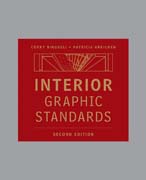
The second edition of Interior Graphic Standards is completely revised with updated and expanded coverage of: Interior material energy use and environmental impact; ADA Accessibility Guidelines; Residential design and construction; Basic building construction types and their impact on interiors; Historic preservation and adaptive reuse of interiors; Life cycle costing and estimating forinterior materials; Behavioral aspects of designing with color; Current issues in office design; Commercial and residential interior renovation for smallerprojects; Current information on computer technology and interior design practice INDICE: Forward. Introduction. Section I Building Elements. Chapter 1: STRUCTURE. Substructure. Superstructure. Floor Construction. Roof Construction. Stairs and Ramps. Chapter 2: SHELL. Exterior Vertical Enclosures. Exterior Horizontal Enclosures. Chapter 3: INTERIOR CONSTRUCTION. Fire Resistive Construction. Acoustic Construction. Seismic Considerations. Gypsum Board Assemblies. Concrete Masonry Units. Architectural Concrete. Stone Walls. Glass Unit Masonry.Prefabricated Partitions. Windows and Glazing. Doors. Raised Floor Construction. Thermal and Moisture Protection. Manufactured and Fabricated Rooms. Chapter 4: INTERIOR FINISHES. Interior Specialties. Wall Finish Requirements. Integral Wall Finishes. Wood Wall Finishes. Tile Wall Finishes. Metal Wall Finishes.Wall Surface Coverings. Painted Finishes. Floor Design Considerations. Metal Deck and Concrete Floor Systems. Hard Floors. Wood Floors. Resilient Floors. Carpet. Ceilings. Chapter 5: BUILDING SERVICES. Conveying Systems. Plumbing Systems. Mechanical Systems. Fire Protection Systems. Electrical Systems. Lighting. Communications Systems. Security Systems. Chapter 6: EQUIPMENT. Toilet and Bath Equipment. Retail Equipment. Personal Care Equipment. Animal Care Facilities. Laundry and Dry Cleaning Equipment. Teller and Service Equipment. Hospitality and Food Service Equipment. Healthcare Equipment. Residential Equipment. Recreational and Performance Equipment. Athletic and Fitness Equipment. Cleaning, Disposal and Recycling Equipment. Chapter 7: FURNISHINGS. Furnishing Contracts and Tests. Textiles. Cabinetry and Casework. Countertops. Art and Accessories. Furniture. Plantings. Window Treatments. Section II Contemporary Issues.Chapter 8: COMPUTING TECHNOLOGIES. The Transition from CAD to BIM. IntegratedProject Delivery. Virtual Collaboration. Software as a Service. The UnwrittenFuture. Chapter 9: EXISTING BUILDING INTERIORS. Historic Restoration and Preservation. Evaluating Hazardous Materials. Recycling Construction and Demolition Waste. Chapter 10: INCLUSIVE DESIGN. Accessibility. Aging in Place. Continuous Care Retirement Communities. Chapter 11: SUSTAINABLE DESIGN. Design, Construction and Operations Issues. Sustainability Strategies. Sustainable Materials. Health Concerns in the Built Environment. Interior Rating Systems and Certifications. Costs and Schedule Implications. Appendix. Anthropometric Data. Proportioning Systems. Graphic Symbols. Classical Interior Architectural Elements.Interior Minimum Uniformly Distributed Loads. INDEX.
- ISBN: 978-0-470-47157-9
- Editorial: John Wiley & Sons
- Encuadernacion: Cartoné
- Páginas: 992
- Fecha Publicación: 22/12/2010
- Nº Volúmenes: 1
- Idioma: Inglés
